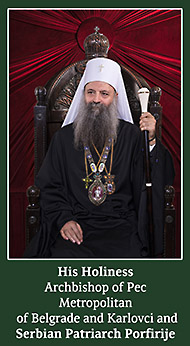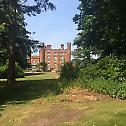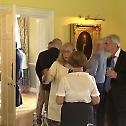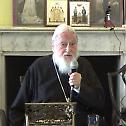Grand Duchess Elizabeth Romanov Society holds symposium presenting archival material on last Romanovs
Report on the Symposium “The Last Romanovs: Archival and Museum Discoveries in Russia and Britain,” held at Cumberland Lodge, Windsor Park by the Grand Duchess Elizabeth Romanov Society on June 20, 2017
The first symposium organized by the Grand Duchess Elizabeth Romanov Society in the UK took place at the magnificent 17th century house called Cumberland Lodge in Windsor Great Park. This place had been visited by Grand Duchess Elizabeth who recommended it to the future Emperor Nicholas II during his visit to England in the year of his engagement, 1894, as a perfect example of a cozy and homely Royal residence. The drawing room of this residence was carefully and professionally converted to the modern conference room which preserved its original decor with royal portraits and photographs on the walls. In the anti-room a small but relevant private collection of china with the monograms of Grand Duchess Elizabeth and Grand Duke Sergei was on display together with other Romanov objects and books (all presented by members of the Society). The windows were opened to the landscape of Windsor park, because of the hot weather, and this perfectly matched the setting. By coincidence on this very day Her Majesty the Queen was expected to pass by in her carriage to open Royal Ascot. We were pleased to get a response to our letters of information about the Symposium from HRH Prince Philip and HRH Prince Charles. These close Royal relatives of Grand Duchess Elizabeth and other Romanovs sent us their good wishes.
The theme of the symposium was chosen to coincide with the centenary of the tragic events of 1917-1918: the abdication of Emperor Nicholas II, the two Russian revolutions and the martyrdoms of the imperial family and the Grand Duchess Elizabeth. Five distinguished experts were invited from Russia and the same number from Britain. A total of forty persons were in attendance.
In his address the Ambassador noted ”the centenary of the tragic turn for Russia and for Romanovs … is a date to contemplate, to think about our past, our history, which is exactly what this event is about”. He commended the Society for its “tireless work in preserving the memory of Grand Duchess Elizabeth and the Russian Imperial Family in Britain.”
The program of the symposium was divided in three parts. The first two speakers of the day dealt with two different Russian imperial coronations, those of 1896 and 1856.
Professor Inessa Slyunkova, former Head Architect of the Kremlin Museums and author of a number of substantial studies of royal palaces and residences was unfortunately not able to be present on the day, due to visa problems, but she communicated with us via Skype. Her subject was the “Decoration of the Kremlin as Sacral Space for the Last Coronation of 1896.” We were able to examine her lavishly illustrated book on the same theme which she had already sent us.
She was followed by Mr. Stephen Patterson, Head of Collections Information Management, Royal Collection Trust, who gave an illustrated talk on “Rare Photographs of the Romanov's Russia During the Time of the Coronation, 1856."
The next three speakers were concerned with the relationship between the Romanovs and the Windsors. Stephen Patterson, replacing a colleague who was unable to attend at the last minute, gave us a fascinating preview of the major exhibition of Russian art and photographs which will be opened at the Queen's Gallery in 2018. We are very grateful to him for this. Mr. Michael Hunter, the Curator of Osborne House, spoke on “Romanovs at Osborne House: Visits and Objects” and showed us some very interesting and rare photographs. He invited us to visit Osborne House to see its rich Romanov collection. Mrs. Coryne Hall, researcher and author of a wonderful biography of the Empress Maria Feodorovna, then spoke on the “Rescue of the Dowager Empress Marie Feodorovna From the Crimea” with many revealing quotes from diplomatic letters, including those from King George V.
The afternoon session was mostly dedicated to Romanov personalities and their files at some archival collections. It began with a talk of Nikolai Misko, Researcher at the State Historical Museum, Moscow (his co-author Dr. Marina Falaleeva, Senior Researcher), on the collection held at that museum which was formerly (until 1947) at the Tsar Nicholas II Museum in Belgrade, founded by prominent members of the Russian emigration in Yugoslavia and elsewhere. Charlotte Zeepvat, author of many works with royal themes, spoke next on the ”Letters of Grand Duchess Maria Alexandrovna of Russia, Duchess of Saxe-Coburg, in the National Archives of Romania in Bucharest” which haven’t been studied before. They revealed a great deal of the personality of Maria Alexandrovna and her uneasy relationship with the Windsors. Dr. Olga Kopylova, Head of Information Department of the State Archive of the Russian Federation, delivered a talk, based on her exhaustive research in the Moscow Secret Police records, on the Grand Duchess Elizabeth's daily activities and journeys during the last eight years of her earthly life, when she was under constant police scrutiny for her own protection. It was entitled “2555 Days in the Life of Grand Duchess Elizabeth Feodorovna.”
The final session of the symposium began with a paper, delivered via Skype, from Fr. Andrei Posternak who is Dean of the History Department at St. Tikhon's Orthodox University in Moscow. It was entitled “The Question of Giving the Title of Deaconesses to the Sisters of the Martha and Mary Convent: Discoveries in the St. Petersburg Archives” (his co-author was Dr. Elena Kozlovtseva). A lively debate resulted from his talk, in which Fr. Andrei took a strong line against any possible revival of the ancient order of deaconesses. Dr. Dmitry Grishin, specialist on the life of Grand Duke Sergey Alexandrovich, then spoke on the “Art Collections of Grand Duchess Elizabeth and Grand Duke Sergey: Recent Discoveries,” describing his work in tracing scattered art works and correcting wrong attributions. He also showed how the art collection of the Grand Duchess Elizabeth reflected her personality.
The final paper was given by Rev. Archpriest Stephen Platt, of the Institute of Orthodox Christian Studies and a founder member of our society, entitled “Fr. Nicholas Gibbes: Teacher to the Royal children and Orthodox Monk: His Romanov Collection and the Issue of Creating a Romanov Museum in Oxford.” Fr. Stephen talked about this remarkable and heroic Englishmen who was close to the Russian Royal Family until their final days. He brought to Britain some treasures from Ekaterinburg which still are not accessible to the public but may be in the future. By way of conclusion, Metropolitan Kallistos added some vivid personal recollections of Fr. Nicholas Gibbes and the Orthodox chapel he established in Oxford after the Second World War. We very much appreciated the Metropolitan's contribution to our event.
In the end, the Chairman of the Society Maria Harwood expressed her special gratitude to those who made this Symposium possible by their prayers, generosity and support. She assured the audience that the proceedings of the symposium will be published soon. She announced a future event organized by the Society, namely the pilgrimage to Isle of Wight to visit Osborne House and St. Mildred’s Church nearby where the elder sister of Grand Duchess Elizabeth Victoria Mountbatten is buried and where the memory of the last Romanovs is kept.
Source: Orthochristian.com





